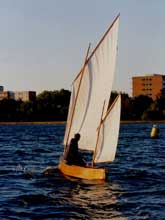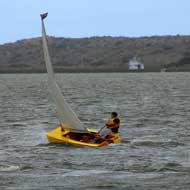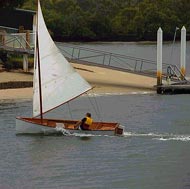Working toward efficient and
well tuned lugsails spritsails and rigs.
Any reasonable level sailor can look at the picture
below and see that this rig is doing most of the right things.
 |
This rig is doing most
of the right things. |
The twist is controlled, the sheeting angles are relatively
narrow (though never sheet the front sail of a boat in tighter
than 10 degrees from the centreline) and the boat is moving
along nicely in a light wind and a leftover chop.
This is what I mean when I say that properly set up traditional
rigs can be effective.
This is a yawl or a ketch that can sail round a racing course
about equal with a Laser.
There are some wrinkles in the head of the mainsail (the "head"
in a 4 sided sail is the edge tied along the upper spar - the
top corner is the "peak") and they are a sign of me
being lazy - but a few are OK when the wind is light and you
are trying to power up the boat.
The other defect is the mizzen is too full. Mizzens usually
end up too full because sailmakers underestimate just how stiff
such short yards, booms and gaffs are if they are designed to
be strong enough.
| the BETH sailing canoe on Lake Burley
Griffin in Canberra many years ago. |

|
The pictures above are of me sailing my first
design - the BETH sailing canoe on Lake Burley Griffin
in Canberra many years ago. BETH is the boat that helped
me work out how to set up these types of sails properly - I
already knew from my racing background what the aims were, but
there are some specific things applicable to traditional rigs.
Which of the traditional rigs has good
performance?
The balance lug rig shown above is certainly one
of the best candidates for a traditional rig that is capable
of very good performance. Any of the rigs that restrict sail
twist as the sheet is eased are OK.
I have used the balance lug on Beth as well as the Goat
Island Skiff and the Drop-in
canoe rig.
Another is the sprit rig - which we used on the OZ
PDRacers.
 |
Note how the twist is
restricted and the mast is bending to depower the sail |
The OZ
PDRacer- the yellow boat above - is sailing in
a good strong breeze. Note how the twist is restricted and the
mast is bending to depower the sail. Because of the cut of the
foot the sail looks like it is sheeted closer than it actually
is - the tip of the boom is just outside the transom corner.
These pictures are all "old hat" for racing sailors
but the mast on this boat cost $50 and the sail is made of polytarp
and cost us $45. When the boat is turned downwind as in the
following picture the sail has little twist and is projected
well to catch the wind. This day I broke the sailing
peak speed record for the class - raising it from
6.5mph to 9.2mph.
Another efficient rig is the lateen - which is a very close
relative of the balance lug. I've used the lateen for a number
of canoes that have been fitted with my "drop in"
outriggers.
Balance lug and sprit rigs will sail rings around a gaff rig
unless the gaff rig has been set up with a modern boom vang.
Sailing rigs with Poor Efficiency - boomless
mainsails
First - there are some good reasons to consider
boomless sails, but if you want the boat to sail really well
in all conditions then boomless is bad.
Performance of such rigs can be OK and there is the argument
of simplicity - for example a boomless sail on a rowing tender
makes a lot of sense - fewer bits to set up for a boat that
is not normally propelled by sails. Cost can also be a good
reason
But this section is to deal with those who say "boomless
rigs are highly efficient".
| When the boat is turned downwind as in this
picture the sail has little twist and is projected well
to catch the wind. |

|
Boomless lugs and boomless "leg of mutton"
sails are inefficient crosswind and downwind because of excessive
sail twist. Any designer who says that they are "efficient"
doesn't have enough sailing experience to make the call or is
getting carried away with the promotional spirit of things.
The only exception to "boomless sucks" is in some
fast multihulls which have a curved traveller track that keeps
the sheet at the right angle all the time. A multi with a straight
traveller and no boom is pretty inefficient as well because
the sheeting angle becomes silly as the sheet is eased and the
sail twists excessively and the bottom of the sail becomes excessively
full.
The reason that the boomed traditional rigs that
I use have a lower performance than modern rigs is also because
of this type of twist.
BUT:-
Why not talk about tuning modern rigs and their huge
range of adjustability?
The modern bermudan rig generally relies on a boom vang to
have the same effect - and that can cost quite a bit of money.
The traditional rigs on the other hand sacrifice something in
fine adjustability and make up for it in simplicity and low
cost.
Modern race boats go completely overboard with adjustable bits
- between a quarter and a third of the $25,000 cost of a 505
(racing dinghy for 2 people) or a Lightweight Sharpie (racing
dinghy for three people) is in fittings, ropes and wires - Ronstan,
Harken and the rest. This would be fine if it increased the
performance by 25% but the reality is more like 5%. But that
is enough to win races.
Traditional rigs generally have a very low part of the cost
involved in these parts - maybe about 5% of the all up cost
- and the boat is already much cheaper anyhow.
In fact we built two OZ PDRacers for less than the cost of
a shroud tension system on a 505 or Australian Sharpie in 2006.
$350 each.
And the tuning of modern rigs is well covered in other places.
I strongly recommend that traditional rig owners have a look
at that information too - it covers the basics very well.
Back to traditional rigs
So you can get on the water cheaply and the boat can still
go well - If both you and the designer have done their jobs.
 |
Another area the designer
is helpful in is in setting up and choosing the rigging
for the boat. |
A large part of getting these rigs to work efficiently is down
to the designer - he/she has to get the sail area right for
the boat and position it correctly and also design the spars
for the correct bending response as the wind strength fluctuates.
There are few designers that actually do a good job of this
part. Iain Oughtred is one of the few who invariably gets it
right with almost everything well positioned and specified.
If the designer understands this properly they can put much
more sail area on the boat and still have it easy to sail in
stronger winds. Before we put together our OZ PDRacers with
the flexible masts and matching sails the largest sensible sails
in the fleet were around 65 square feet. The OZ PDRs had 86sq
ft when we first launched them and they were docile to handle
and very quick.
Another area the designer is helpful in is in setting up and
choosing the rigging for the boat. There is a big difference
in the cost of blocks (pulleys) from Ronstan's basic range vs
their deluxe. In general if the right rope and the right fitting
have been chosen by the designer and the correct placement and
attachment specified there is no need to pay Ronstan or Harken
the extra for ball bearing blocks.
The sailmaker is important too - a sailmaker who is interested
in these types of sails makes a big difference too (though with
the PDRacer we have included the plan to make sails for yourself
at a fraction of the cost).
| A sailmaker who is interested in these types
of sails makes a big difference too |

|
If the designer gets the rig right, the sailmaker was interested
in the project and you get the details right then the boat will
sail REALLY WELL - and perhaps more importantly - just be trouble
free.
As far as the owner's responsibility - getting these rigs to
work well is more a question of detail - just getting little
things right - get them all right and the boat will GO!
Setting up and tuning sprit rigs and sprit sails
Here
is a photoseries on Flickr about how to rig an
OZ PDRacer. Despite its humble appearance the OZ PDRacer is
quite sophisticated with a hollow flexible mast (made of wooden
floorboards) and a lightweight hull (29kg 65lbs). Many of the
methods will be familiar to good sailors of small boats - I've
stolen them from all over the place through my sailing career.

